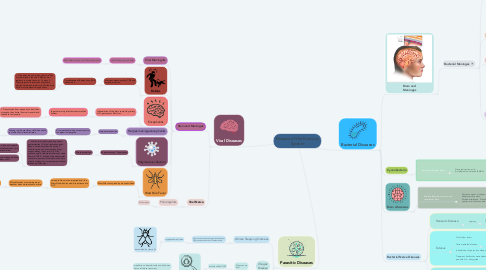
1. Viral Diseases
1.1. Brain and Meninges
1.1.1. Viral Meningitis
1.1.1.1. self- limiting and non-fatal
1.1.1.1.1. 40% Enteroviruses and 15% mumps virus
1.1.2. Rabies
1.1.2.1. infectious agent in saliva, CNS and peripheral nerves.
1.1.2.1.1. Causative agent: Rabies virus, RNA rhabdovirus
1.1.3. Encephalitis
1.1.3.1. Inflammation of the brain caused by variety of Togaviruses or Flavivirus
1.1.3.1.1. Togavirus mainly infect horses more than humans
1.1.4. Herpes meningoencephalitis
1.1.4.1. Herpes simplex virus
1.1.4.1.1. Virus reaches brain by ascending from the trigeminal ganglion.
1.1.5. Polymovirus infection
1.1.5.1. Polyomaviruses / Papoviruses
1.1.5.1.1. Myelin production
1.1.6. West Nile Fever
1.1.6.1. West Nile virus spread by mosquito bites
1.1.6.1.1. carried in blood of an imported bird, the West Nile arbovirus made its entrance into NYC.
1.2. Viral Nerve
1.2.1. Poliomyelitis
1.2.1.1. Polioviruses
2. Parasitic Diseases
2.1. African Sleeping Sickness
2.1.1. Trypanosoma brucei gambiense and Trypanosoma brucei rhodesiense
2.1.1.1. trypanosome strains
2.1.1.1.1. transmitted by tsetse fly
2.2. Chagas' Disease
2.2.1. Trypanosoma cruzi
2.2.1.1. protein called Tc52
2.2.1.1.1. transmitted by bugs
3. Bacterial Diseases
3.1. Brain and Meninges
3.1.1. Bacterial Meninges
3.1.1.1. Meningococcal Meningitis
3.1.1.1.1. Neisseria meningitidis
3.1.1.2. Haemophilus Meningitis
3.1.1.2.1. Haemophilus influenza
3.1.1.3. Streptococcus Meningitis
3.1.1.3.1. Streptococcus pneumonia
3.1.1.4. Listeriosis
3.1.1.4.1. Listeria monocytogenes
3.1.1.4.2. Adhesion proteins (Ami, Fbp A, flagellin)
3.1.1.4.3. Transmitted by improperly processed dairy products and cross placenta
3.1.1.4.4. Treatment : Ampicillin and Bactrim
3.1.1.4.5. 1. food borne transmission by improper processed milk, cheese, meat and vegetables. 2. pathogen cross blood - brain barrier 3. Causes severe inflammation of the brain.
3.2. Cyanobacteria
3.2.1. Associate with algal bloom
3.2.1.1. Neurotoxic amino acid, b-methylamino-L-alanine (BMAA)
3.2.1.1.1. 1. BMAA produced in place of serine, protein are damaged, can build up and kill cell. 2. The motor neuron of brain and spine die, progressively paralyzing the body.
3.3. Brain Abscesses
3.3.1. Infection that grows in mass and compresses brain
3.3.1.1. Causative agent: multispecies such as Streptococcus aureus, Enterobacteriaceae, Pseudomonas species, and other anaerobes.
3.3.1.1.1. 1. Pathogen enter via head wounds 2. Enters the blood and the brain. 3. Infection grow in mass and compress the brain.
3.4. Bacterial Nerve Diseases
3.4.1. Hansen's Disease
3.4.1.1. Leprosy
3.4.1.1.1. Mycobacterium leprae, Mycobacterium lepromatosis
3.4.2. Tetanus
3.4.2.1. Clostridium tetani
3.4.2.2. Toxin mediated disease
3.4.2.2.1. Tetanolysin and Tatanospasmin
3.4.2.3. Introduction of spores into deep wounds
3.4.2.4. Treatment: Antibiotics metronidazole, penicillin G or doxycycline
3.4.3. Botulism
3.4.3.1. Clostridium botulinum
3.4.3.1.1. Botulinum Exotoxin
